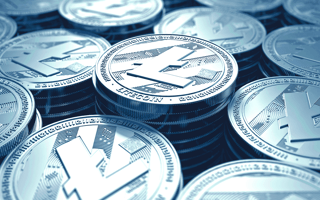Litecoin is the second cryptocurrency and first altcoin ever to be created. It’s best known for delivering fast transaction speeds at near-zero costs. The open-source, peer-to-peer platform launched in 2011 as a hard fork from Bitcoin, meaning it is a spinoff from the original cryptocurrency that permanently split into its own network.
What Is Litecoin?
Litecoin is the second cryptocurrency and first altcoin ever created. Developed by Charlie Lee in 2011, Litecoin is known for its fast transaction speeds and extremely low transaction fees, plus as a hard fork from the Bitcoin cryptocurrency.
Charlie Lee, a former engineer at Google and Coinbase, created Litecoin in 2011, and it is considered to be the second cryptocurrency platform ever developed.
Lee and his team modeled Litecoin to be the lightweight version of Bitcoin. It’s made from the same source code known for its top-notch security protocol and serves a similar function at a fraction of the cost at faster speeds. This makes Litecoin, nicknamed “the silver to Bitcoin’s gold,” ideal for small purchases and quick-turnaround transactions.
These features have ranked Litecoin in the top ten cryptocurrencies by market capitalization for most of its existence, according to CoinMarketCap.
Litecoin Fast Facts:
- Litecoin’s maximum “block time,” or time it takes to verify a transaction, is 2.5 minutes — four times faster than Bitcoin.
- Of Litecoin’s 84 million total coin supply, 73 million LTC have been mined.
- Litecoin price hit an all-time high of $386.45 on May 9, 2021, according to CoinMarketCap.
- The Litecoin network activated a Mimblewimble Extension Blocks upgrade in May 2022, which allows users to keep transaction amounts confidential between the sender and receiver.
How Does Litecoin Work?
The open-source, peer-to-peer digital currency platform works similar to all other blockchain-based projects in that a distributed ledger records transactions and shares information.
Each transaction is verified via consensus among network participants, ultimately securing the platform. In Litecoin’s case, this algorithm is written as a proof-of-work protocol. These consensus mechanisms aid block production by encoding transactions in arbitrary cryptographic proofs called hashes — a sort of complex mathematical puzzle — to be solved by miners, a type of transaction validator, in a process known as mining. This eliminates the need for third-party intervention, enabling a decentralized system to operate in a trustless and permissionless manner sans central authority.
While Litecoin holds its own as a standalone player in the crypto space, it has dually functioned as a testnet for Bitcoin soft forks, said Chief Marketing Officer Marie Tatibouet of DeFi investment and Web3 venture building firm Tacans Labs.
“The protocol [has been] a proving ground of sorts for newer Bitcoin innovations,” she said. For example, Litecoin deployed and executed two protocol upgrades in 2017 — the Lightning Network, for speed, and Segregated Witness, for scalability — before a final call was made to integrate both of the solutions to Bitcoin. As major errors would cause less damage on the Litecoin network, which shares the same underlying technology as Bitcoin’s, these protocols are implemented there first until reports come out clean, and no major incidents are detected.
“As such, Litecoin [functions as] an excellent coin for pure payments [while also] always being open to deploying innovations,” she continued.
Advantages of Litecoin
Fast, Cheap Transactions
In a snapshot, Litecoin’s novel mining algorithm processes virtually instant transactions with near-zero transaction fees to anyone in the world. With minimal trade-off, the platform hosts great scalability and above-grade security without sacrificing its status as a decentralized platform.
Stable Prices
“Litecoin has been one of the most resilient cryptocurrencies during times of economic turmoil,” said Fraser Matthews, president at NetCoins, Canada’s first fully regulated, publicly owned crypto exchange. “This is likely due to Litecoin’s low price point, which makes it a more affordable option for investors during tough economic times.”
Established Community
As one of the first cryptocurrencies, Matthews notes another invaluable asset unique to Litecoin that keeps the first true altcoin relevant in a notoriously volatile market: “Litecoin has a large and loyal community of supporters,” he said. “They have been critical in helping Litecoin to grow and prosper [and are] likely to continue to be a major force in the cryptocurrency’s future.”
Designed to Be Mined With User-Grade Equipment
Harry Turner, founder of investing education website the Sovereign Investor, points to a double-edged sword to Litecoin’s accessibility.
“One of the original aims of Litecoin was to make the mining process more accessible to a wider group of people, including individuals,” Turner said, an effort that is highlighted by the protocol’s ability to run on consumer-grade hardware. This aspect leveled the playing field between small and large-scale miners, which in turn spread the Litecoin supply across a wider pool of investors in hopes of creating a more decentralized version of Bitcoin, he said.
Disadvantages of Litecoin
Commercial Mining Rigs Are Gaining Traction
While Litecoin sought to bring more mining power to individuals, this win was short lived and encountered some challenges.
“Unfortunately, miners adapted their technology and developed their own ASIC machines for Litecoin mining. Since then, the mining landscape has become much less competitive — centering around a small handful of powerful mining pools,” Turner said. “Ironically, this has led Litecoin to become more centralized than Bitcoin.”
The main leverages that positions Litecoin over Bitcoin — lower fees and speedy transactions — are actively being worked on by Bitcoin developers, as seen with developments such as the Lightning Network, a layer-2 solution added in 2018.
“If Bitcoin manages to overcome its scalability issues through these developments, then Litecoin will lose its main competitive edge — rendering it a more centralized and less widely-known version of Bitcoin,” Turner said. “If this becomes the case, then the outlook for Litecoin is bleak.”
Doesn’t Support Smart Contracts and Decentralized Applications
Litecoin is not designed to host smart contracts and decentralized applications like Ethereum does, which makes it harder to build on top of, according to Daniel Polotsky, founder and chairman of the board at CoinFlip, a Bitcoin ATM operator.
Seen by Some as a Bitcoin Copycat
“Also, it’s often viewed as a ‘copycat’ of Bitcoin, which means the wider cryptocurrency community does not trust it as much as its counterpart,” Polotsk said.
“In order to compete with Bitcoin and Ethereum,” he continued, “Litecoin’s developers will need to find some sort of value-add for the platform besides simply being a fast, ‘silver’ alternative to Bitcoin’s gold standard.”
Litecoin vs. Bitcoin
Litecoin: Faster and Cheaper to Mine than Bitcoin
One of the standout contrasts between these crypto cousins — made obvious to users as Litecoin’s foremost selling point — is in their transaction speeds. Litecoin quarters Bitcoin’s 10-minute mining speeds at just 2.5 minutes per block, maximum.
This is made possible by Litecoin’s alternative hashing algorithm, opting for one that uses a less resource-intensive Scrypt instead of Bitcoin’s SHA-256.
Charles Ellingsen, an early adopter of Litecoin, explained some of the changes he’s witnessed over the years. Originally entering crypto in 2014, he now heads Unity Network, a software development company that builds NFT-based ticketing systems, as its CEO and founder.
“The Litecoin team recognized that [SHA-256] could be performance-intensive and difficult to implement in the future. To address this, they created a modification to the algorithm called Scrypt,” Ellingsen said. While the password-based key derivation function is computationally less intensive, he noted some of the drawbacks: “The Scrypt algorithm is a sequential memory-hard function, which is processed slower on graphics processing units and requires a lot of memory to solve a single hash.”
This modification also translates to higher accessibility in terms of hardware, operating off of the same technology pre-built into commercial computers most people own at home. Bitcoin, on the other hand, requires costly virtual mining devices that use application-specific integrated circuits, or ASICs.
Bitcoin: More Popular and Higher Demand
“The key difference between Litecoin and Bitcoin is the supply and demand of each,” Ellingsen said. “Although Bitcoin is more popular and has a larger demand, Litecoin has a much smaller market capacity.”
Litecoin has a higher maximum number of coins, set at 84 million, of which 73 million have been mined as of May 2023. With over 19 million of its coins already mined, Bitcoin’s network will be made whole at its hard cap of 21 million coins.
“The demand for Bitcoin has risen so high that it commands a very high cryptocurrency-to-dollar exchange rate,” Ellingsen continued, with May 2023 numbers showing $26,000 per BTC to Litecoin’s $91 per LTC.
Litecoin vs. Ethereum
Litecoin: Built for Simple, Fast, Reliable Transactions
Litecoin was created with the intention of being an accessible, low-cost and quick option for peer-to-peer payments, while Ethereum is more so built for use on decentralized applications and related software. Litecoin also uses a proof-of-work consensus mechanism, a robust and trusted protocol stack for transactions. Ethereum, in contrast, uses a proof-of-stake consensus mechanism, which is scalable and less energy-intensive but may be less trusted than its founding counterpart.
Litecoin: Cheaper Transactions Than Ethereum
As of 2023, the average Litecoin transaction fee stands at less than 2 cents, whereas Ethereum’s average transaction fee hovers between $2 and $28. This makes Litecoin a more financially viable option for frequent crypto buyers and sellers.
Ethereum: Smart Contract Support
Ethereum is able to use smart contracts in its payments, while Litecoin cannot. Smart contracts offer features like automation and self-execution of agreements when carrying out payments, making Ethereum a more preferable choice when it comes to complex transactions like loans.
Ethereum: Infinite Supply
There’s no concern of Ethereum running out of coins, as the cryptocurrency yields an infinite supply. In comparison, Litecoin is capped off at a supply of 84 million coins, increasing the risk of market scarcity and deflation rates for the cryptocurrency if the maximum is reached.
Where to Buy, Sell and Trade Litecoin
Coinbase is a well-known name for those looking to buy, sell and manage cryptocurrencies. After signing up on Coinbase, users can immediately purchase and store Litecoin using their bank, debit card or online payment options like PayPal. Users can also earn select rewards after buying their first cryptocurrency through the platform.
Kraken users can buy, sell and trade from over 200 cryptocurrencies, one of which is Litecoin. The Kraken platform offers overall lower trading fees compared to popular exchanges like Coinbase, as well as crypto deposit and withdrawal limits of up to $10,000,000 daily for Pro-level users. As a note, Kraken’s services aren’t available to users in the states of New York or Washington.
Binance’s crypto exchange platform lets users buy, trade and sell over 350 different cryptocurrencies, including Litecoin. Users can create an account for free and buy and convert Litecoin from several options of fiat currency. Buyers can also buy and trade Litecoin directly from other Binance users and store earnings on the platform.






